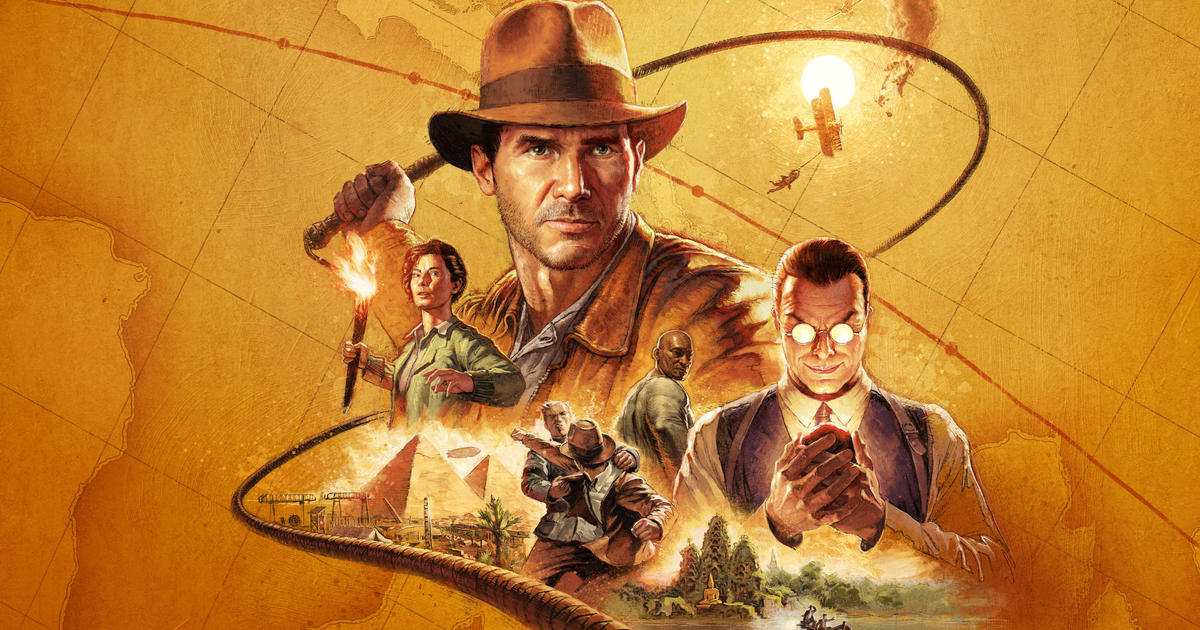As one of the major titles to emerge from Microsoft’s acquisition of Bethesda, Indiana Jones and the Great Circle proved a critical hit on Xbox Series X, S and PC in late 2024 – and now, four months later, it arrives on PlayStation 5 consoles. To cut to the chase, this translation to PS5 and PS5 Pro is a success all round. It compares well to Series X in particular, with developer MachineGames realising an authentic take on the Indiana Jones films using its Motor engine – a customised branch of ID Tech 7, which itself powered the likes of 2020’s Doom Eternal. It’s impressive stuff: from the near 1:1 recreation of Raiders of the Lost Ark‘s opening scene to the sprawling Vatican city, each level plays host to all manner of whip-cracking, stealth, puzzling and sleuthing. And once again, we get ray traced global illumination – RTGI – into the bargain on PS5 consoles, allowing for more accurate indirect lighting and shading at 60 frames per second. So how does the experience match up to Series X? And what about PS5 Pro?
The Great Circle broadly has parity feature-wise with the Series X release though it’s worth noting that PS5 adds adaptive trigger support on its DualSense controller. As a result, melee combat, pulling the trigger on a gun, or using the whip, come with varying levels of feedback. Beyond that, the visual setup is remarkably straightforward: MachineGames optimises PS5 purely around a 60fps experience with RTGI as the de facto means of lighting its environments. There is no graphics mode toggle, nor any alternative 30fps option pushing higher fidelity settings, but the upshot is that we get a polished single means of playing the game.
Looking at the platform comparisons, there are mixed fortunes here, but in general terms, most of the core visual settings see Series X, PS5 and Pro matched. Texture quality, shadow resolution, and world detail draw across the forest all run at the same settings between the consoles. Likewise, the quality of the RTGI also translates to both PS5 machines. In effect, this setting limits the objects within the scene affected by the ray traced diffuse lighting pass, and continues to operate below PC presets. It’s a concession to hit a 60fps target on consoles while keeping RTGI in place, but the result is still impressive overall. Otherwise, volumetric quality is also matched between base PS5 and Series X – though it appears we get a higher setting on PS5 Pro – the net benefit being there’s marginally less aliasing along the streaks of light spilling through the college windows, though again it falls short of PC’s best volumetric setting.
In every other respect, there is parity between the three. Frustratingly this also extends to the game’s occasional rough points on Series X, notably in the presentation of shadows. Even four months on from release, there’s a lingering issue with shadow filtering on Xbox, which stays in place on the PS5 consoles as well. In short, shadow maps lining the floors of the college will abruptly step up in detail based on your proximity to it – and this update occurs in set, metre-length increments to make matters more obvious. It’s a shame that shadow filtering is such a distraction and it’s really the only blemish on what’s otherwise a well presented package. There is also a small discrepancy in brightness on Series X, owing to its default setting being five clicks higher by default – but that’s the full extent of the difference.
In terms of rendering resolutions, MachineGames keeps it simple on base PS5 but enhances the Pro version to allow a higher max pixel output. Dynamic resolution scaling is in play, with PS5 and Series X each running at a 1200p to 1800p range, while PS5 Pro adjusts between a higher 1440p lower bounds, rising to 4K at peak. All use id Tech’s TAA method to clean up visual noise, with the only side-effect being the presence of occasional banding on movement across busy points within the frame – like fine stitching on clothing. These DRS ranges don’t tell the whole story, either. As raw metrics they only point to the extreme best and worst cases, but the average, practical resolution tends to rest in between those values. For example, focusing on PS5 and Series X – which share the same 1200-1800p range – it’s clear that Series X often runs at a higher resolution on average. In almost every scenario Series X renders more pixels per frame, resulting in a sharper resolve – especially visible in zooming into the dense jungle detail of the first level.
This Series X image quality advantage is curious but consistent with another id Tech 7 game, Doom Eternal. In both cases we have a use of hardware-based variable rate shading – VRS – which was engineered by Microsoft’s Advanced Technology Group. Also much like Doom Eternal, The Great Circle shares the same 1800p target resolution, where VRS reduces the bandwidth taken up by pixel shading threads. It’s a huge benefit for taxing, ray traced titles in this mould, and ultimately frees up Series X’s GPU to push to higher resolutions along its DRS scale. This would go a long way to explaining the sharper image next to PS5, where hardware VRS is not supported – and despite their matching DRS ranges. Just as with Doom Eternal though, compared to PS5, there are subtle downsides to this feature – notably a more obvious form of ‘block noise’. Neither console is free of visual noise, even with film grain and chromatic aberration disabled – but artefacts are more apparent on Series X. It’s not a massive distraction at a regular viewing distance, and these issues are outweighed by the way VRS affords Series X a boost in overall clarity.
The PS5 Pro benefits are worth touching on too. While hardware based VRS is in theory a feature of Pro, it doesn’t seem to use it here. Even so, PS5 Pro excels for one reason alone: its ability to generate even higher resolution frames, afforded by a beefier 16.7TF GPU. Going up to a native 4K means the fine thread-work of clothing appears pin sharp, especially compared to base PS5, as does the presentation of grass in the opening jungles. PS5 Pro pushes the cleanest image of the trio here – even if benefits in settings outside of this are rather limited.
Jumping to performance testing, The Great Circle benefits from strong optimisation on PS5 and PS5 Pro alike, for any regular gameplay. Each is tightly optimised around a 60fps target, where areas flooded with NPCs, or the dense jungles simply fly by at 60. For any variances in on-screen load, their dynamic resolution setups are able to compensate – though it’s not always a perfectly smooth ride. Much like Series X, there are two snags that carry over to PS5 systems. Firstly there is an auto-saving feature which triggers a small hitch – a frame-time spike that kicks at invisible thresholds around the world. It’s more-so obvious around the Vatican city, with each mini stutter being followed by a small auto-save symbol – and it’s a shame it’s not more discrete. The second point relates to the in-engine cutscenes. As authentic as each cinematic is, every camera cut is coupled with a string of dropped frames. Most likely, this is a buffer used by the renderer to allow the physics-based elements – like clothes – to settle for a few frames first and avoid a distracting position refresh with every cut. Still, the end result is PS5, PS5 Pro and Series X all drop frames at these exact same moments and there’s nothing to split them.
With all that being said, there is one repeatable drop during an in-engine scene, later in the crypts of the Vatican. This is a rare, outlier case really, given that everything else runs so well, but it does underline a Series X advantage. While Indy studies a parchment, a vehicle crashes through the ceiling, causing a burst of alpha and particle effects to fill the frame. In this moment, Series X has the GPU headroom to get closest to 60 frames per second, with the expected hitches on every camera cut. PS5 takes a more drastic hit, down to the 40s, while PS5 Pro finds a midway point between all three machines – with some drops to the 50s. Again this is a rare moment, and worth highlighting – and shows another potential advantage of Series X’s hardware VRS.
Summarising, Indiana Jones and the Great Circle makes a successful leap on to PS5 platforms and despite its delayed release, everything we loved about the Xbox experience is intact. In comparison, the Series X is a preference over the base PS5 – given the often higher average resolution on Xbox – but the margin isn’t wide enough to be a deal-breaker. PS5 owners still get a superb take on MachineGames’ latest work. In every other respect the two are matched, right down to the consistency of their 60fps readings in gameplay and the use of RTGI. Meanwhile, PS5 Pro enjoys an extra benefit in image clarity over the other consoles with a higher 4K maximum target, while still hitting that same stable 60fps. The only criticism here is one I’d level at all three consoles: the poor shadow filtering remains a rough spot that only the PC version is currently able to fix. Beyond that, this remains a superb game that’s highly recommended on all systems.

